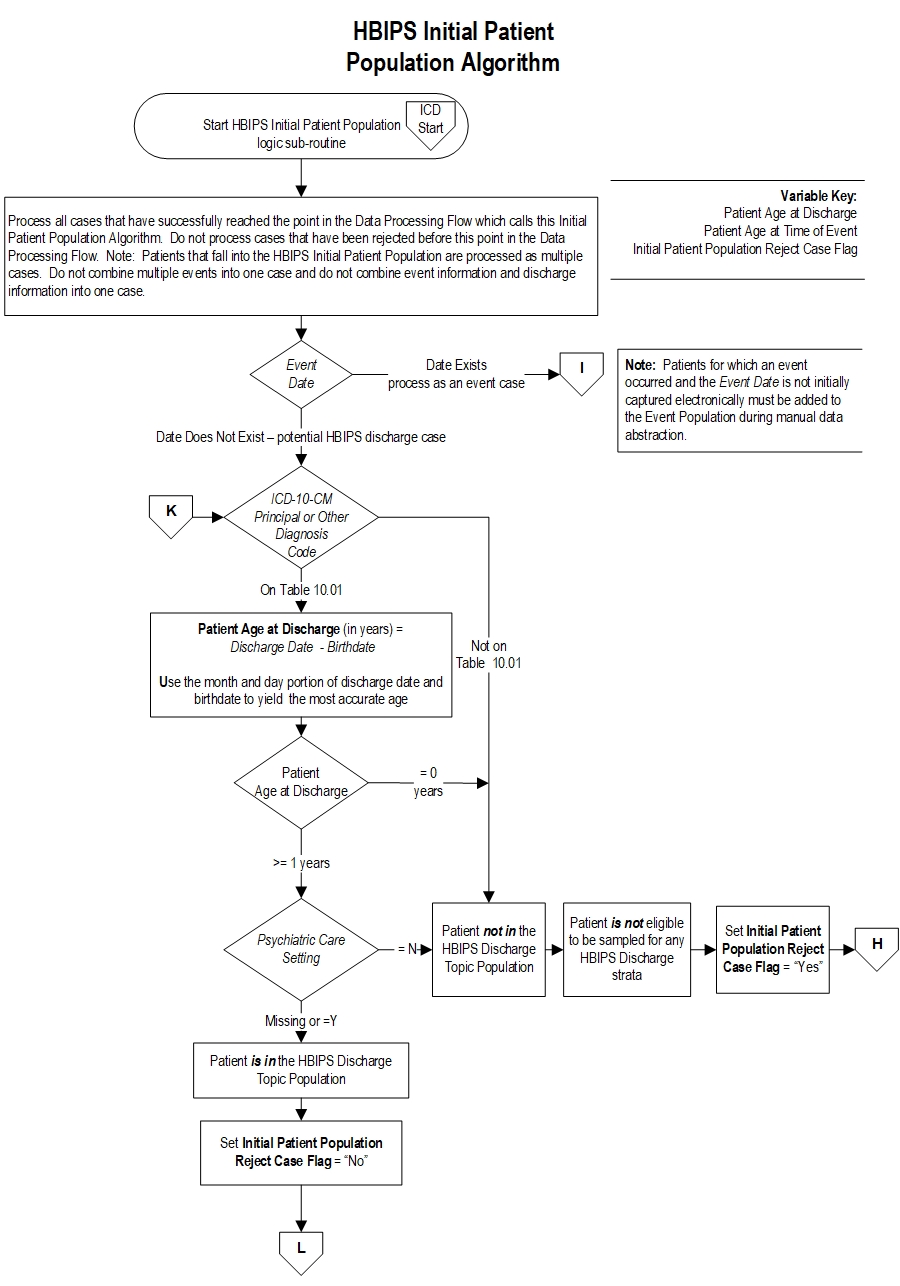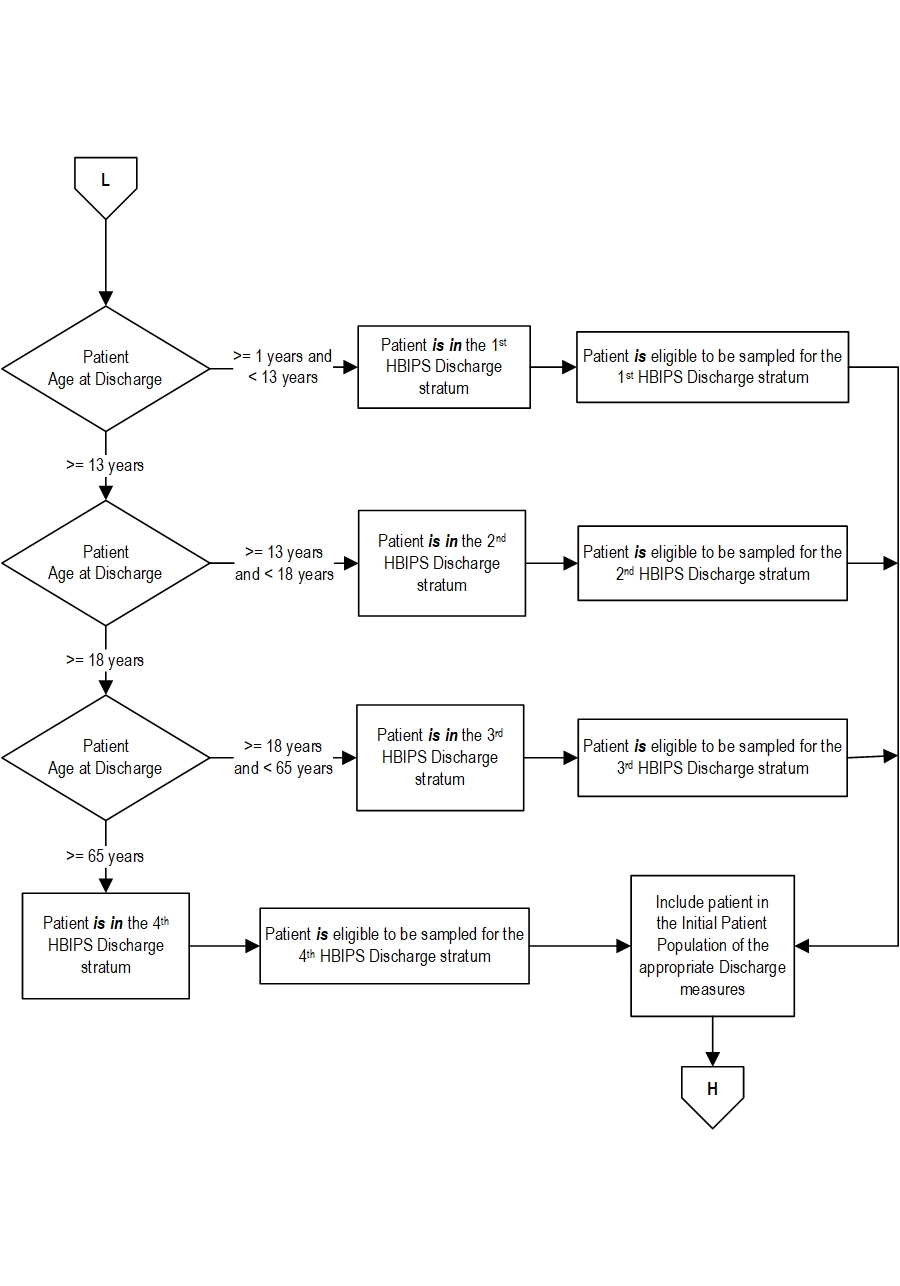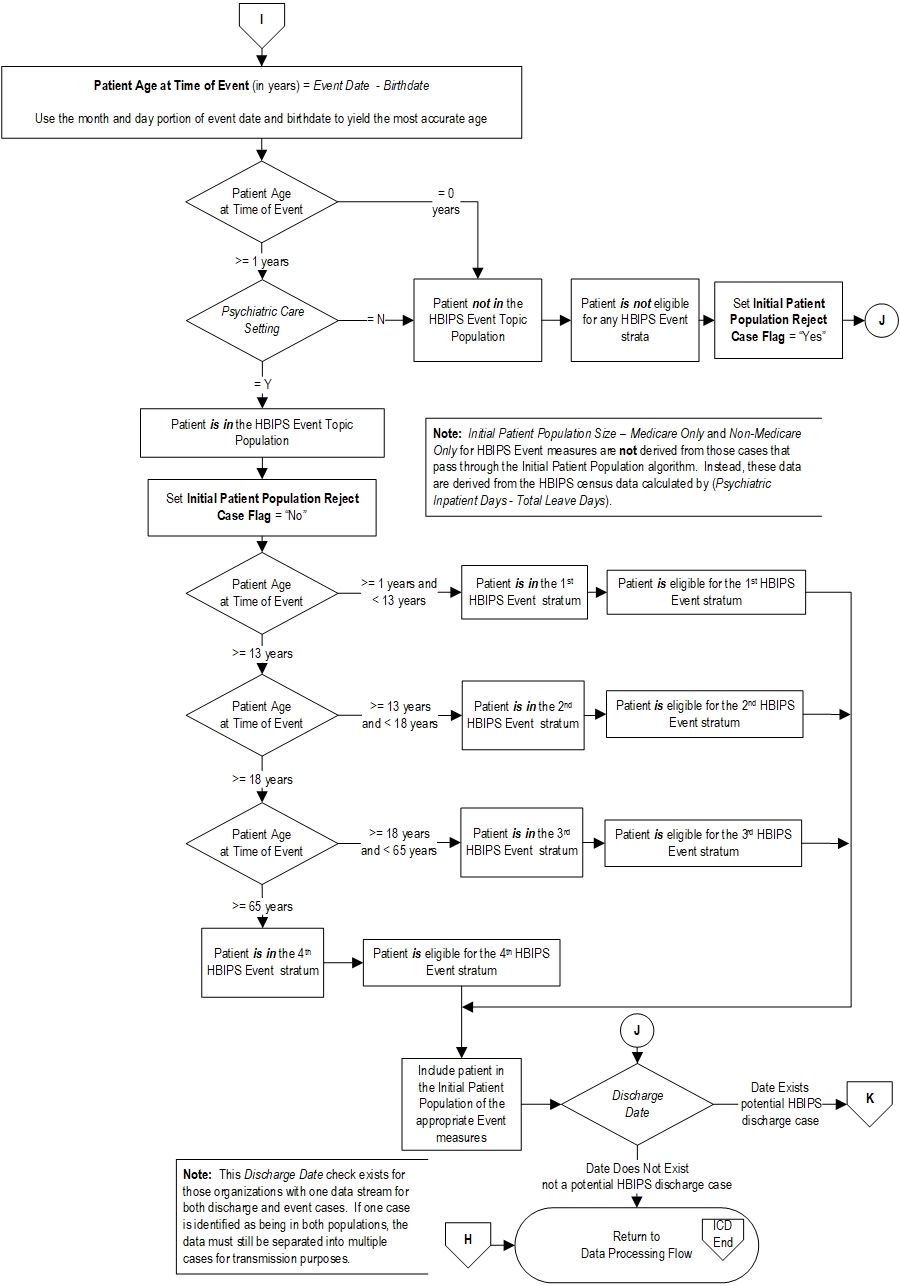Measure Information Form
Version 2021A
Hospital Based Inpatient Psychiatric Services (HBIPS)
Set Measures
| Set Measure ID | Measure Short Name |
|---|---|
| HBIPS-1 | Admission Screening for Violence Risk, Substance Use, Psychological Trauma History and Patient Strengths completed |
| HBIPS-2 | Hours of physical restraint use |
| HBIPS-3 | Hours of seclusion use |
| HBIPS-5 | Patients discharged on multiple antipsychotic medications with appropriate justification |
General Data Elements
| Element Name | Collected For |
|---|---|
| Admission Date | All Records, |
| Birthdate | All Records, |
| CMS Certification Number | Optional for All Records, |
| Discharge Date | All Records, Not collected for HBIPS-2 and HBIPS-3 |
| Hispanic Ethnicity | All Records, |
| ICD-10-CM Other Diagnosis Codes | All Records, Optional for HBIPS-2, HBIPS-3 |
| ICD-10-CM Principal Diagnosis Code | All Records, Optional for HBIPS-2, HBIPS-3 |
| ICD-10-PCS Other Procedure Codes | All Records, Optional for All HBIPS Records |
| ICD-10-PCS Other Procedure Dates | All Records, Optional for All HBIPS Records |
| ICD-10-PCS Principal Procedure Code | All Records, Optional for All HBIPS Records |
| ICD-10-PCS Principal Procedure Date | All Records, Optional for All HBIPS Records |
| Measure Category Assignment | All Records, Calculation, Used in calculation of the Joint Commission's aggregate data. |
| Payment Source | All Records, Optional for HBIPS-2 and HBIPS-3 |
| Psychiatric Care Setting | All Records, HBIPS |
| Race | All Records, |
| Sex | All Records, |
Algorithm Output Data Elements
| Element Name | Collected For |
|---|---|
| Measure Category Assignment | All Records, Calculation |
| Measurement Value | Calculation |
Measure Set Specific Data Elements
Related Materials
Hospital-Based Inpatient Psychiatric Services (HBIPS) Measure Set Initial Patient Population
The HBIPS measure set is unique in that there are two distinct Initial Patient Populations within the measure set, one for the discharge measures (HBIPS-1, HBIPS-5) and the other for event measures (HBIPS-2 and HBIPS-3).
Initial Patient Population for Discharge Measures (HBIPS-1, HBIPS-5)
The general population of the HBIPS discharge measures can be identified by using four data elements that are common to the discharge performance measures in the HBIPS set:- ICD-10-CM Principal Diagnosis Code or ICD-10-CM Other Diagnosis Codes
- Discharge Date
- Birthdate
- Psychiatric Care Setting
There are four distinct strata within the HBIPS Discharge Topic Population; each is identified by a specific age range. The patients in each stratum are counted in the HBIPS Initial Patient Population for discharge measures of multiple measures.
| Discharge Measures | Age Strata | Initial Patient Population definition |
|---|---|---|
| HBIPS-1a and 5a (overall measures) | Age greater than and equal to 1 year | The count of all patients in strata 1, 2, 3, and 4 |
| HBIPS-1b and 5b | Age 1 year through 12 years | The count of all patients in stratum 1 |
| HBIPS-1c and 5c | Age 13 years through 17 years | The count of all patients in stratum 2 |
| HBIPS-1d and 5d | Age 18 years through 64 years | The count of all patients in stratum 3 |
| HBIPS-1e and 5e | Age greater than and equal to 65 years | The count of all patients in stratum 4 |
Patients discharged from the hospital with an ICD-10-CM Principal or Other Diagnosis Code for Mental Disorders as defined in Appendix A, Table 10.01 are included in one of the HBIPS Strata Initial Populations for discharge measures and are eligible to be sampled if they have:
Discharge Stratum 1 — Age 1 year through 12 years stratum — A Patient Age at Discharge (Discharge Date -— Birthdate) >= 1 year and < 13 years Discharge Stratum 2 - Age 13 years through 17 years stratum — A Patient Age at Discharge (Discharge Date -— Birthdate) >= 13 years and < 18 years Discharge Stratum 3 - Age 18 years through 64 years stratum — A Patient Age at Discharge (Discharge Date -— Birthdate) >= 18 years and < 65 years Discharge Stratum 4 - Age greater than and equal to 65 years stratum — A Patient Age at Discharge (Discharge Date -— Birthdate) >= 65 yearsInitial Patient Population for Event Measures (HBIPS-2 and HBIPS-3)
The population of the HBIPS event measures can be identified by using two data elements that are common to the event performance measures in the HBIPS set:- Event Date
- Psychiatric Care Setting
| Event Measures | Age Strata | Initial Patient Population definition |
|---|---|---|
| HBIPS-2a and 3a (overall measures) | Age greater than and equal to 1 year | The count of all patients in strata 1, 2, 3, and 4 |
| HBIPS-2b and 3b | Age 1 year through 12 years | The count of all patients in stratum 1 |
| HBIPS-2c and 3c | Age 13 years through 17 years | The count of all patients in stratum 2 |
| HBIPS-2d and 3d | Age 18 years through 64 years | The count of all patients in stratum 3 |
| HBIPS-2e and 3e | Age greater than and equal to 65 years | The count of all patients in stratum 4 |
Patients for which an event occurs (Event Date exists) while in a Psychiatric Care Setting (='Y') in the hospital are included in one of the Strata Initial Populations for the event measures. There is no sampling for the HBIPS event measures. All patients in the Initial Population for HBIPS event measures are automatically sampled.
Event Stratum 1 — Age 1 year through 12 years stratum — A Patient Age at Time of Event (Event Date -— Birthdate) >= 1 year and < 13 years Event Stratum 2 - Age 13 years through 17 years stratum — A Patient Age at Time of Event (Event Date —- Birthdate) >= 13 years and < 18 years Event Stratum 3 - Age 18 years through 64 years stratum — A Patient Age at Time of Event (Event Date -— Birthdate) >= 18 years and < 65 years Event Stratum 4 - Age greater than and equal to 65 years stratum — A Patient Age at Time of Event (Event Date —- Birthdate) >= 65 years


Sample Size Requirements
Note For Joint Commission purposes, the HBIPS measure set is not included in the aligned Global Sampling methodology. All patients meeting the definition of the HBIPS Initial Patient Populations are eligible to be sampled, abstracted, and submitted to the Joint Commission. Sample Size Requirements for HBIPS Discharge Measures (HBIPS-1, HBIPS-5)Hospitals that choose to sample have the option of sampling quarterly or sampling monthly. A hospital may choose to use a larger sample size than is required. Hospitals whose Initial Patient Population size is less than the minimum number of cases per quarter/month for the stratum cannot sample that stratum.
Regardless of the option used, hospital samples must be monitored to ensure that sampling procedures consistently produce statistically valid and useful data. Because the sample for a measure set will rarely be equal to the effective sample due to exclusions and contraindications, hospitals selecting sample cases MUST submit AT LEAST the minimum required sample size.
The following sample size tables for each option automatically build in the number of cases needed to obtain the required sample sizes. For information concerning how to perform sampling, refer to the Population and Sampling Specifications section in this manual.
Quarterly Sampling
For hospitals selecting sample cases for the HBIPS discharge measures, a modified sampling procedure is required. Hospitals selecting sample cases for this set must ensure that each individual stratum's population and effective quarterly sample size meets the following conditions:- Select within each of the four individual measure strata. The effective quarterly sample size within a stratum is at least 44 cases per quarter. Cases are placed into the appropriate stratum based upon the patient's age.
- The required quarterly sample size is at least 20% of the stratum population for the quarter.
Based on Initial Patient Population for the HBIPS Discharge (HBIPS-DSC) Measures
| Hospital's Measures | |
|---|---|
| Average Quarterly Stratum Initial Patient Population Size “N” |
Minimum Required Stratum Sample Size “n” |
| > 877 | 176 |
| 221 —- 877 | 20% of the Initial Patient Population |
| 44 -— 220 | 44 |
| < 44 | No sampling; 100% of the Initial Patient Population is required |
Monthly Sampling
For hospitals selecting sample cases for HBIPS discharge measures, a modified sampling procedure is required. Hospitals selecting sample cases for this set must ensure that each individual strata population and effective monthly sample size meets the following conditions:- Select within each of the four individual measure strata. The effective monthly sample size within a stratum is at least 15 cases per month. Cases are placed into the appropriate stratum based upon the patient's age.
- The required monthly sample size is at least 20% of the stratum population for the month.
Based on Initial Patient Population for the HBIPS Discharge (HBIPS-DSC) Measures
| Hospital's Measures | |
|---|---|
| Average Monthly Stratum Initial Patient Population Size “N” |
Minimum Required Stratum Sample Size “n” |
| > 295 | 60 |
| 76 —- 295 | 20% of the Initial Patient Population |
| 15 —- 75 | 15 |
| < 15 | No sampling; 100% of the Initial Patient Population is required |
Sample Size Examples
All sampled strata in HBIPS should be used in the calculation of all HBIPS discharge measures. All of the HBIPS discharge measures' specific exclusion criteria are used to filter out cases that do not belong in the measure denominator. Using HBIPS-1b as an example, include cases covering all sampled strata, although the measure-specific exclusion criteria would only allow cases with an age of 1 year through 12 years to be included in the denominator.
- Quarterly sampling:
When applicable, larger hospitals must also abide by the required quarterly sample sizes for the four individual measure strata a minimum of 44 or 20% of population required sample cases per stratum when Initial Patient Population size is 44 or greater.
- The HBIPS Initial Patient Population sizes for a hospital are 5, 100, 221, and 876 patients for each stratum respectively per quarter. The required quarterly sample sizes would be 5, 44, 45, and 176.
- The 1st stratum is less than the minimum required quarterly sample size, so 100% of this stratum is sampled.
- The 2nd stratum has 100 patients per quarter, which falls in the average quarterly population size of 44 to 220 patients, so 44 cases are sampled.
- The 3rd stratum has 221 patients per quarter, which requires a 20% sample size, of 45 cases (twenty percent of 221 equals 44.2 rounded to the next highest whole number = 45).
- The 4th stratum has 876 patients per quarter, which is more than the maximum condition, so a minimum of 176 cases are required to be sampled.
- The HBIPS Initial Patient Population sizes for a hospital are 5, 100, 221, and 876 patients for each stratum respectively per quarter. The required quarterly sample sizes would be 5, 44, 45, and 176.
- Monthly sampling:
When applicable, larger hospitals must also abide by the required monthly sample sizes for the four individual measure strata a minimum of 15 required sample cases per stratum when Initial Patient Population size is 15 or greater.
- The HBIPS Initial Patient Population sizes for a hospital are 5, 45, 294 and 400 patients respectively in July. The required monthly sample sizes would be 5, 15, 59, and 60.
- The 1st stratum is less than the minimum required monthly sample size, so 100% of this stratum is sampled.
- The 2nd stratum has 45 patients per month, which falls in the average monthly population size of 15 to 75 patients, so 15 cases are sampled.
- The 3rd stratum has 294 patients per month, which requires a 20% sample size, of 59 cases (twenty percent of 294 equals 58.8 rounded to the next highest whole number = 59).
- The 4th stratum has 400 patients per month, which is more than the maximum condition, so a minimum of 60 cases are required to be sampled.
- The HBIPS Initial Patient Population sizes for a hospital are 5, 45, 294 and 400 patients respectively in July. The required monthly sample sizes would be 5, 15, 59, and 60.
Sampling Requirements for HBIPS Event Measures (HBIPS-2 and HBIPS-3)
The measures in HBIPS-EVT (HBIPS-2 and HBIPS-3) are not eligible for sampling and will use the entire Initial Patient Population for reporting.CPT® only copyright 2019 American Medical Association. All rights reserved. CPT® is a registered trademark of the American Medical Association.
You, your employees and agents are authorized to use CPT® only as contained in The Joint Commission performance measures solely for your own personal use in directly participating in healthcare programs administered by The Joint Commission. You acknowledge that the American Medical Association (“AMA”) holds all copyright, trademark and other rights in CPT®.
Any use not authorized herein is prohibited, including by way of illustration and not by way of limitation, making copies of CPT® for resale and/or license, transferring copies of CPT® to any party not bound by this Agreement, creating any modified or derivative work of CPT®, or making any commercial use of CPT®. License to use CPT® for any use not authorized herein must be obtained through the American Medical Association, Intellectual Property Services, AMA Plaza, 330 North Wabash Avenue, Suite 39300, Chicago, Illinois 60611-5885. Applications are available at the American Medical Association Web site, www.ama- assn.org/go/cpt.
U.S. Government Rights This product includes CPT® which is commercial technical data, which was developed exclusively at private expense by the American Medical Association, 330 North Wabash Avenue, Chicago, Illinois 60611. The American Medical Association does not agree to license CPT® to the Federal Government based on the license in FAR 52.227-14 (Data Rights - General) and DFARS 252.227-7015 (Technical Data - Commercial Items) or any other license provision. The American Medical Association reserves all rights to approve any license with any Federal agency.
Disclaimer of Warranties and Liabilities. CPT® is provided “as is” without warranty of any kind, either expressed or implied, including but not limited to the implied warranties of merchantability and fitness for a particular purpose. Fee schedules, relative value units, conversion factors and/or related components are not assigned by the AMA, are not part of CPT®, and the (AMA is not recommending their use. The AMA does not directly or indirectly practice medicine or dispense medical services. The responsibility for the content of this product is with The Joint Commission, and no endorsement by the AMA is intended or implied. The AMA disclaims responsibility for any consequences or liability attributable to or related to any use, non-use, or interpretation of information contained or not contained in this product.
This Agreement will terminate upon notice if you violate its terms. The AMA is a third party beneficiary to this Agreement.
Should the foregoing terms and conditions be acceptable to you, please indicate your agreement and acceptance by clicking below on the button labeled “accept”.